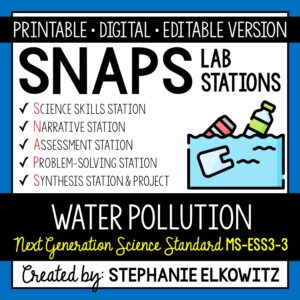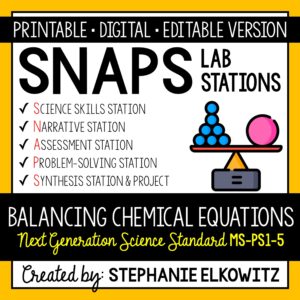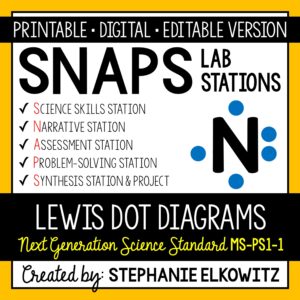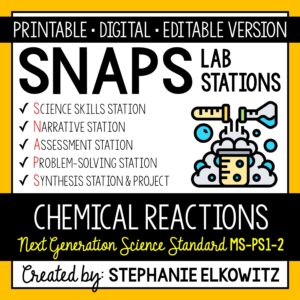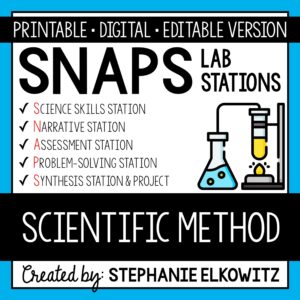4-ESS3-2 & MS-ESS2-2 Volcanoes Lab
$7.00
An engaging lab activity designed to enhance students’ understanding of the internal and external structure of a volcano. Aligned with NGSS 4-ESS3-2 and MS-ESS2-2.
Description
4-ESS3-2 MS-ESS2-2 Volcanoes Lab Preview
SNAPs Lab Stations Activities require students to use science, math, literacy, problem-solving and engineering skills. They are designed to enhance students’ understanding of scientific concepts and help students apply scientific ideas to the real world. Each station activity promotes skills so to develop students into proficient and competent scientific thinkers.
SNAPs lab activities have five components:
• Science Skills Station to develop science skill proficiency
• Narrative Station to build science literacy
• Assessment Station to evaluate learning and understanding
• Problem-Solving Station to foster engineering design
• Synthesis Station and Project to inspire higher-order learning
DIGITAL LABORATORY – DISTANCE LEARNING & DIGITAL CLASSROOMS
• This lab is offered in a digital format to support digital classrooms & distance learning.
• The digital lab activity is designed to work with Google Slides and Microsoft PowerPoint
• The digital lab activity CANNOT be edited. However:
– Students can manipulate text boxes
– Students can create tables, graphs and diagrams
– Students can insert images and drawings
GOOGLE FORM ASSESSMENT STATION
• The assessment station is offered as a self-grading Google Form.
• Questions are all short answer and are 100% editable.
• Suggestions for use are included in the download.
DISTANCE LEARNING COMPATIBILITY
SNAPs lab activities are rated for their ease with distance – independent learning. Refer to the preview for more information about how well this laboratory works in a fully digital classroom and with distance learning.
EDITABLE DOCUMENTS
This download includes an editable word document (docx file) of all lab components:
• Pre-Lab and Post-Lab Activities
• The Lab Overview
• Lab Station Activities and Questions
• Directed Synthesis Project (when applicable)
Important Notes:
• Diagrams, illustrations, tables and graphs essential to lab activities are included
• Illustrative clipart is NOT included
• Editable documents and rubrics are included with the FREE SNAPs Setup Guide
Editable files allow you to:
• Edit the scope of the activities so to suit your students’ needs
• Edit the materials required based on resource availability
• Create single-period “mini-labs” using activities at the individual skills stations
The activities at each station in this lab are detailed below.
Volcanoes Lab Stations Activity Learning Objectives
1. Describe the internal and external structure of a volcano.
2. Explain how volcanic eruptions change Earth’s surface.
3. Discuss the role of volcanic activity in the formation of the Hawaiian Islands.
4. Assess the geologic hazards (problems) associated with volcanic eruptions.
5. Evaluate technologies that allow scientists to monitor and forecast volcanic activity.
6. Demonstrate the explosive, destructive and constructive nature of a volcanic eruption.
Science Skills Station
Students will study the role of volcanoes in the formation of the Hawaiian Islands. Students will make observations of Hawaiian volcanoes, evaluate topographic maps of theHawaiian Islands and graph data on the age of volcanoes relative to the most active Hawaiian volcano, Kilauea. Students will analyze and interpret data to understand how volcanoes formed the Hawaiian Islands.
Narrative Station
Students will read about the structure of volcanoes. Students will watch videos about the internal and external structures of a volcano. If time allows, students will watch a video about one of the newest islands on Earth, created from a volcano.
Assessment Station
At this station, students will answer questions about key terms and ideas relating to volcanoes. Students must employ lower, mid and higher order thinking skills to answer these questions.
Problem-Solving Station
Students will assess the hazards (problems) caused by volcanic eruptions. Then students will evaluate USGS monitoring and forecasting tools that aim to mitigate the negative effects of volcanic eruptions.
Synthesis Station
Students will compose a CER (claim-evidence-reasoning) report to summarize the lab. Students are provided the claim statement and must support the claim with observations, data and other information gathered in the lab. Students will explain how the evidence supports the claim using scientific reasoning.
Synthesis Project
Students will have a choice of 11 projects. Refer to the SNAPs Lab Stations Best Practices and Setup Guide for directions and suggestions on how to conduct the project.
Directed Synthesis Project
Students can conduct one of the 11 standard synthesis projects, but I strongly suggest using the directed synthesis project. In the directed synthesis project, students will build a model of a volcano and use household materials to create “an explosion” of gas, “molten rock” and “ash.” Students will observe how the explosion of these materials is destructive and constructive to the area around the volcano.
This download includes:
• A pre-lab assignment and post-lab reflection
• Directions and questions for each lab station
• Student recording sheets
• Teacher Key
Additional Materials Required:
3 Computers or tablets
Colored Pencils
For the Directed Synthesis Project:
2 Pieces of white cardstock
Plastic bottle (such as an empty water bottle)
Scissors
Tape
Paint and paintbrushes (optional)
Baking soda
Vinegar
Dish soap
Ground coffee
Measuring cup(s)
Straw
Funnel
Important Note
This lab has extra activities at the science skills and narrative station so to address both Next Generation Science Standards. Choose the activities that best suit the needs of your classroom – you won’t have time to complete all of them in a 90 minute block of time. Alternatively, allow additional time to complete all activities at these stations.
LINKS TO VIDEOS
This laboratory requires internet to access videos. Videos are hosted on SafeShare.TV so to safely watch and share educational YouTube videos without ads, comments and other distractions. Shortened and full link(s) to SafeShare.TV included. Full link to original YouTube video(s) included.
NEXT GENERATION SCIENCE STANDARDS
This laboratory satisfies NGSS 4- ESS3-2 and MS-ESS2-2. It combines the three dimensions of science learning – science and engineering practices, disciplinary core ideas and crosscutting concepts – to meet the standard. This lab also makes interdisciplinary connections to STEM, Math CCSS and ELA CCSS to build the appropriate skills.
TERMS OF USE
• All rights reserved by Stephanie Elkowitz.
• This product is to be used by the original purchaser only.
• Intended for classroom and personal use only.
• Copying for more than one teacher, classroom, department, school, or school system is prohibited.
• This product may not be distributed or displayed digitally for public view.
• Failure to comply is a copyright infringement and a violation of the Digital Millennium Copyright Act (DMCA).




